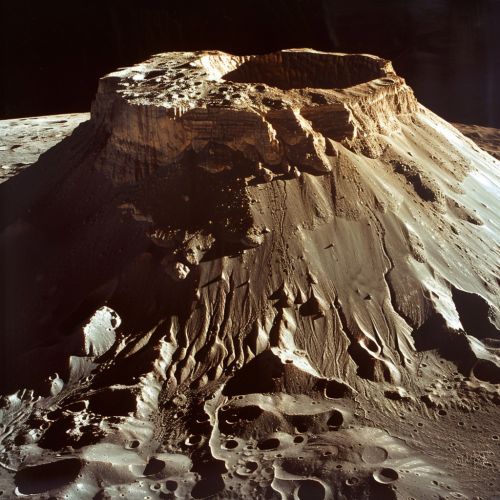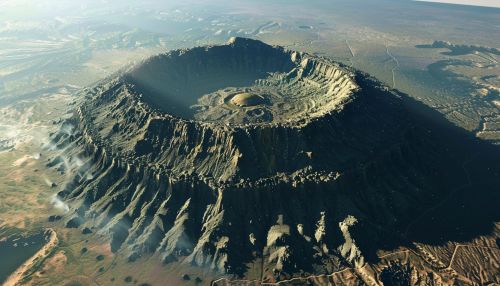Meteorite impact
Introduction
A meteorite impact occurs when a meteorite—a solid piece of debris from an object, such as a comet, asteroid, or meteoroid—survives its passage through the atmosphere and impacts the surface of a planet or moon. These events have played a significant role in shaping the geological and biological history of Earth and other celestial bodies. The study of meteorite impacts encompasses a variety of scientific disciplines, including geology, astronomy, physics, and biology.
Historical Context
The understanding of meteorite impacts has evolved significantly over time. Early civilizations often interpreted meteorite falls as divine or supernatural events. The scientific study of meteorites began in earnest in the 19th century, with the recognition that these objects originated from space. The discovery of impact craters, such as the Barringer Crater in Arizona, provided concrete evidence of the effects of meteorite impacts on Earth's surface.
Formation and Types of Meteorites
Meteorites are classified into three main types: stony, iron, and stony-iron. Stony meteorites, which are composed primarily of silicate minerals, are the most common. Iron meteorites consist mainly of metallic iron-nickel, while stony-iron meteorites contain roughly equal amounts of silicate minerals and metallic iron-nickel.
Stony Meteorites
Stony meteorites are further divided into two subcategories: chondrites and achondrites. Chondrites contain small, spherical particles called chondrules, which are among the oldest materials in the solar system. Achondrites lack chondrules and are believed to have originated from differentiated planetary bodies.
Iron Meteorites
Iron meteorites are composed predominantly of iron and nickel and are believed to originate from the cores of differentiated planetary bodies. They are characterized by a distinctive crystalline structure known as the Widmanstätten pattern, which is revealed when the meteorite is cut and etched.
Stony-Iron Meteorites
Stony-iron meteorites contain both silicate minerals and metallic iron-nickel. They are divided into two main groups: pallasites and mesosiderites. Pallasites consist of olivine crystals embedded in a metallic matrix, while mesosiderites are brecciated mixtures of silicate and metallic components.
Impact Cratering
Meteorite impacts create craters, which are classified based on their size and morphology. The study of impact craters provides valuable insights into the history of meteorite impacts and the processes involved in crater formation.
Simple Craters
Simple craters are relatively small, bowl-shaped depressions with a raised rim. They typically form from the impact of smaller meteorites and lack complex internal structures.
Complex Craters
Complex craters are larger and exhibit more intricate features, such as central peaks, terraced walls, and flat floors. These craters form from the impact of larger meteorites and involve more complex geological processes.


Multi-Ring Basins
Multi-ring basins are the largest and most complex impact structures. They consist of multiple concentric rings and can span hundreds of kilometers in diameter. These basins are typically formed by the impact of very large meteorites or asteroids.
Effects of Meteorite Impacts
Meteorite impacts have significant effects on the environment and can influence geological and biological processes.
Geological Effects
Meteorite impacts can cause a variety of geological effects, including the formation of impact craters, shock metamorphism, and the generation of impact melt. Shock metamorphism refers to the structural and mineralogical changes that occur in rocks subjected to the extreme pressures and temperatures of an impact event.
Biological Effects
Meteorite impacts can have profound effects on biological systems. Large impacts can cause mass extinctions by triggering wildfires, tsunamis, and climate changes. The most famous example is the Cretaceous-Paleogene extinction event, which is widely believed to have been caused by a large asteroid impact.
Detection and Study of Meteorite Impacts
The detection and study of meteorite impacts involve a combination of fieldwork, laboratory analysis, and remote sensing techniques.
Fieldwork
Fieldwork involves the direct examination of impact craters and the collection of meteorite samples. Geologists use a variety of tools and techniques to map and analyze the features of impact structures.
Laboratory Analysis
Laboratory analysis of meteorites and impact-related materials provides detailed information about their composition, structure, and history. Techniques such as mass spectrometry, X-ray diffraction, and electron microscopy are commonly used in these studies.
Remote Sensing
Remote sensing techniques, such as satellite imagery and radar mapping, are used to identify and study impact craters that are difficult to access. These methods allow scientists to detect and analyze impact structures on Earth and other planetary bodies.
Notable Meteorite Impacts
Several meteorite impacts have had significant scientific and historical importance.
Chicxulub Crater
The Chicxulub Crater, located on the Yucatán Peninsula in Mexico, is associated with the Cretaceous-Paleogene extinction event. This impact is believed to have caused the extinction of the non-avian dinosaurs and many other species.
Tunguska Event
The Tunguska event was a massive explosion that occurred in 1908 in Siberia, Russia. It is believed to have been caused by the airburst of a small asteroid or comet. The explosion flattened an estimated 2,000 square kilometers of forest.
Vredefort Crater
The Vredefort Crater in South Africa is one of the largest and oldest known impact structures on Earth. It is estimated to be over 2 billion years old and spans approximately 300 kilometers in diameter.
